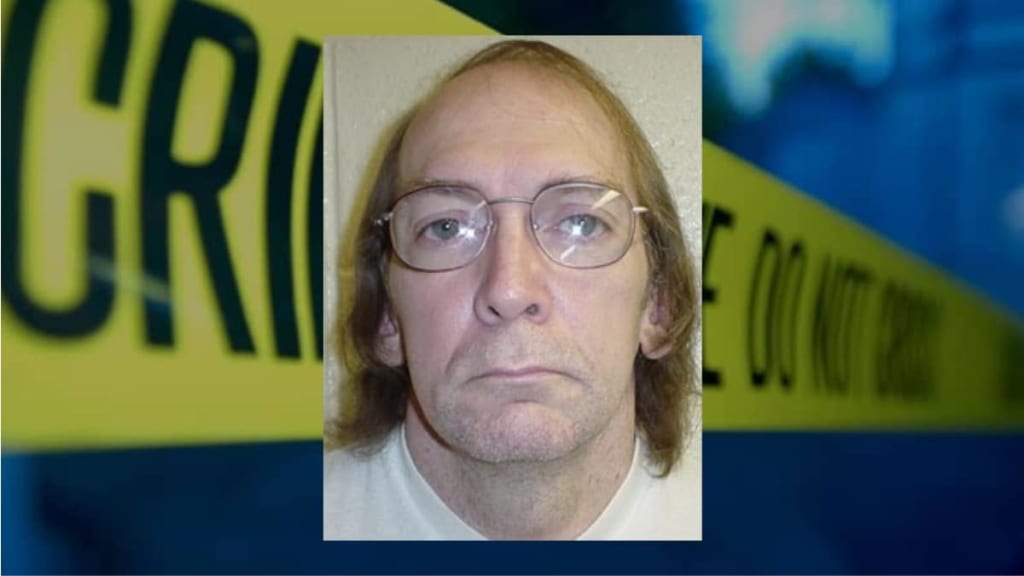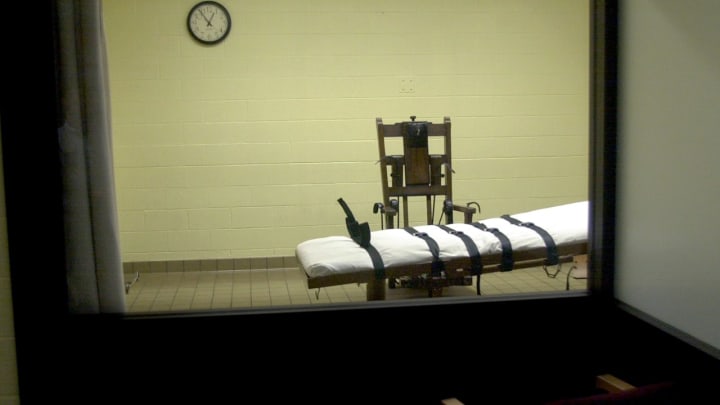The Bloody Truth (Pt. 5)
Drug Fueled Death

It is often said that drugs and alcohol go hand in hand with the lifestyle of a killer. The case of the Gilligan family murders from Evansville, Indiana, is just such a case. Donald Ray Wallace, Jr. admitted to being in a drug-induced state of "strike hard, strike fast, don't stop until you win or are dead" when he broke into the family home of the Gilligans, a young Evansville family. That night would leave Evansville stunned and four innocent people dead.
Donald Ray Wallace, Jr. was born September 3, 1957, and was immediately thrown into a life of unstructured chaos. Young Donald was often devoid of both parents, instead, being shuffled from one family member or friend to another. It didn't take long for Wallace to find himself involved with the justice system, as his first brush with the law was at the seemingly tender age of ten. By the age of eleven, Wallace was living in the Evansville Psychiatric Children's Center.
Though he was a very smart child, his school work was of little importance and his goal was often trouble. He found trouble through his teenage years, and it culminated with a prison sentence for auto theft when he was seventeen. In and out of jail, with no real ties to any family and always on the lookout for the next score, Donald Ray Wallace, Jr. found himself robbing the home of Ralph Hendricks. Although he was successful in attaining items from the Aspen Drive home of Mr. Hendricks, Wallace moved his efforts to the house next door, intending to rob it as well. He entered the home of thirty-year-old Patrick Gilligan, his wife, Theresa (30) and his children, Lisa (5) and Greg (4) through the back door. He placed masking tape over the window to reduce the noise, shattered the window in the door, reached through the hole that was left and unlocked the door. He rummaged through a few rooms in the house and entered the garage to see what he could find. What he found was the Gilligans, who had just arrived home.

The Gilligan family. (Photo Credit: 14WFIE)
Patrick Gilligan pulled in to the driveway of his Aspen Drive home on Evansville's north side for what would prove to be his last time that fateful January day.
Next to him was his wife, Theresa and in the back seat sat their children, Lisa and Gregory. The garage door opened and Patrick found himself face-to-face with a methamphetamine-fueled monster. In defense of his family, Patrick attempted to attack and subdue the stranger that was standing in his garage.
Wallace overtook him quickly and shot him, dropping him instantly, but the wound didn't kill Patrick. Wallace used a cord from a vacuum cleaner found in the house to tie up the family. Once Patrick was injured and tied up, Wallace instructed Theresa to tie up her children, back to back. Theresa did as she was told, never crying or worrying for herself. Her only goal was to comfort her terrified children. Wallace made the decision that the adults simply had to die. The family could identify him. He shot Theresa in the head, killing her in front of her children. The children were both shot in the head, one at a time and then in an act of final brutality, Donald Ray Wallace, Jr., used Patrick Gilligan's own barbell about the head and face of the already shot and tied-up Gilligan.
Just like that, one man had callously taken the lives of four others. He calmly gathered the things he had stolen from both houses, climbed back in the blue Plymouth he had driven to the neighborhood in and drove away.
Judge, Jury, and Execution

A death chamber, similar to the one used at Indiana State Prison in the execution of Wallace.
Ralph Hendricks called for police assistance the moment he returned home and found it burglarized. Indiana State Trooper Thomas Snyder was called to the home to take the report on the break-in. In the course of his investigation, Trooper Snyder walked to the house next door to see if the occupants were home and if they had heard anything. Knocking on the front door was an effort in futility and Snyder decided that since it appeared to him that nobody was home, perhaps that home, too, had been burglarized. At the backdoor, Trooper Snyder could see the damage to the door. With the presence of exigent circumstances, the trooper entered the home for a welfare check and found the bodies of the family in the living room.
The investigation began with a neighborhood sweep. Officers knocked on the door of every home in the north side Evansville neighborhood, asking if anyone had seen or heard anything out of the ordinary that day. Several neighbors had seen a blue Plymouth in the area that morning that didn't belong to any of the neighbors and was out of place enough to be memorable. It didn't take long to identify the car and its owner, Richard Milligan. Milligan was well known to the authorities in Evansville, and the car had been used in several previous burglaries. Police thought they had their man, but their hopes of an expeditious end to the investigation were dashed when they found Milligan already in the Vanderburgh County Jail on a burglary charge.
Police knew the car belonged to Milligan, so they had a starting place. Inquiring of Milligan at the jail, investigators found he had loaned his car to his girlfriend, Debbie Durham. Debbie, who had legal problems of her own, didn't hesitate to tell police that she had loaned the car to Donald Ray Wallace, Jr. She and her sister, Donna Madison, both told investigators that they had witnessed Wallace behind the wheel of the car. Madison went on to say that Wallace had a jacket slung over his shoulder and he had asked everyone at the house for some matches. He found a lighter that he took outside and used to set the jacket on fire. A neighbor, Sherry Grayson, also witnessed the fire in the back yard and a man fitting the description of Donald Ray Wallace, Jr., standing over it. Officer John Crosser found remnants of the jacket, wedding rings without the stones and pieces of glass with masking tape on it that was later found to match the hole in the window of the back door of the Gilligan home.
Wallace was located the same day in the attic of Mark Boyles and Anita Hoeche, where he had been hiding since the couple picked him up earlier in the day. Wallace was arrested and held at the Vanderburgh County Jail while investigators continued to build an airtight case against him, a task they would have little trouble accomplishing.
Debbie Durham testified that Wallace showed up at her house on January 14, 1980, walking in the door and peeling off his clothes with a request for her to wash them. Durham stated that Wallace had blood on him and some kind of "fleshy-white matter" stuck to his jeans. She asked him what it was, and he told her "it had to be brains because he had "shot them all in the head."She also testified that Wallace told her that he thought he had possibly broken Patrick's neck before he shot him as a result of the initial struggle. Mark Boyles and Anita Hoeche also testified that Wallace told them that he the Gilligan family had surprised him and he "had to shoot them all.". Randy Rhinehart and William Madison (brother of Donna Madison) testified that Wallace had tried to sell him several items on January 14, 1980, and that those items included a citizen's band radio, police scanner, and rings. Most damning to his case was the picture of Wallace with Debbie Durham posing with all of the items the men testified Wallace had tried to sell them as well as guns and money from the homes of Ralph Hendricks and Patrick Gilligan.
Wallace did not hesitate with his defense. He was crazy and he could prove it! That defense did hold up through four hearings, a total of two years before he was found fit to stand trial and that the whole defense had been a ruse to keep him out of prison. Wallace created an elaborate story about the CIA and the Masons, who were trying to put him in front of a firing squad to prevent him from releasing secret matters, including information concerning an Iranian hostage situation that was taking place. He further lamented that the police, CIA and Masons were using listening devices to keep up with his every movement.
Wallace had an IQ of 130, and it showed in his performance in support of his defense. It wasn't until letters he had written to his girlfriend surfaced that the whole production fell apart. He admitted to her in his letters that he was faking it all. Further investigation found that he told his cellmates that he was "only crazy when non-prisoners were around." His cellmates further testified that Wallace used his medication to his benefit, trading them among inmates and saving them up at one point so he would appear overly sleepy during a court hearing. Once found out, he was found competent to stand trial. It was a trial that ended with Wallace being found guilty and sentenced to death.
The execution of Donald Ray Wallace, Jr., took place a quarter-century after the murders of the Gilligan family. During his stay on death row at the Indiana State Prison, Wallace wrote letters to the sister of Patrick Gilligan and several to the now-defunct Evansville Press. In the letters, he explained his reasoning, finally, for killing Lisa and Gregory. "I didn't want them to grow up orphans. That's a hard life," explained Wallace. He also professed that he was a changed and reformed man, walking with Christ in the moments before his death. The reason for his crime spree that day, he explained, wasn't to kill anyone. It was simply to steal belongings to feed his drug habit. He says he lost control the day of the killing because, "I was a dope fiend. I had no moral center. I had no spiritual center. I had no rational center. It's a simple fact of life; you live and grow and mature, and for the most part, we become better people."
Donald Ray Wallace, Jr., visited with a few friends, declined clergy, and watched television while he ate his last meal. The meal consisted of filet mignon, baked potato, soup and chocolate truffle cake from local restaurant Damon's Grill. After being strapped to the table, Wallace said his final words, "I hope everyone can find peace with this," and then signaled his executioner to begin. At twenty-three minutes past midnight, March 10, 2005, Wallace was pronounced dead.
At the time of Wallace's execution, family and friends of the Gilligan family gathered at St. Theresa's Catholic church, where the Gilligan's were married, for a memorial service. The memorial was a beautiful one, with friends and family telling and retelling stories of days past. The days before Donald Ray Wallace, Jr., ended the lives of a family that will live on in the hearts and minds of those who knew and loved them.
About the Creator
Phoenixx Fyre Dean
Phoenixx lives on the Oregon coast with her husband and children.
Author of Lexi and Blaze: Impetus, The Bloody Truth and Daddy's Brat. All three are available on Amazon in paperback format and Kindle in e-book format.






Comments (1)
I just watched this entire story on ID Discovery. The man should have died a year after he did this. Why we let these monsters to live for 25 more years it's not reasonable.